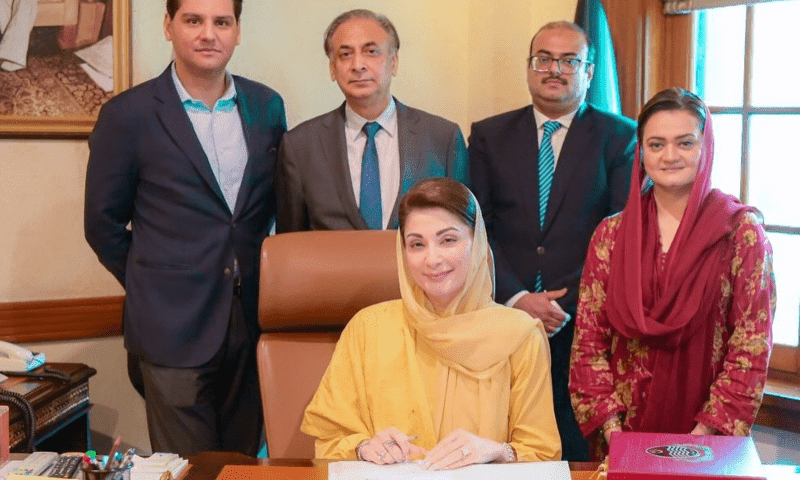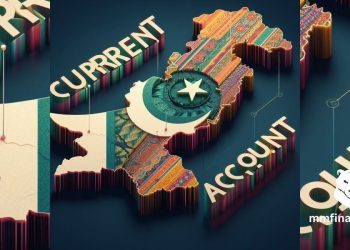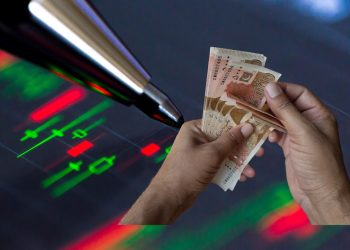Amid significant in-house protests by the opposition, the Punjab government, led by the Pakistan Muslim League-Nawaz (PML-N), presented a Rs5.45 trillion budget for the fiscal year 2024-25. Despite the surplus budget of Rs630 billion, there are no new plans to tax the agriculture and real estate sectors adequately, despite pressure from the International Monetary Fund (IMF).
PUNJAB BUDGET 2024-25 BREAKDOWN
Overview
- Budget Total: Rs5.45 trillion
- Surplus: Rs630 billion
- Key Sectors Lacking New Taxation: Agriculture, Real Estate (Despite IMF Pressure)
REVENUE AND EXPENDITURE
- Projected Revenue: Rs4.643 trillion
- Federal Divisible Pool (NFC Award): Rs3.683 trillion
- Provincial Revenue: Rs960 billion (54% increase from previous year)
- Punjab Revenue Authority: Rs300 billion
- Board of Revenue: Rs105 billion
- Excise and Taxation: Rs57 billion
- Non-Tax Revenue: Rs488 billion
- Projected Expenditure: Rs4.816 trillion
KEY BUDGET FEATURES
- Annual Development Programme (ADP): Rs842 billion (28% increase from Rs655 billion)
- Focus Areas: Education, Health, Agriculture
- New Initiatives: Laptop Distribution, Kissan Card, Free Solar Panels for low electricity consumers
MAJOR CHANGES AND AMENDMENTS
- Provincial Fees and Taxes Rationalization
- Court Fees Act of 1870: Fees increased
- Stamp Duty Act of 1899: Stamp paper values increased
- Punjab Urban Immovable Property Tax Act of 1958: Self-assessment mechanism; property tax based on capital value
- Motor Vehicle Registration Fees: Based on vehicle’s total value rather than engine capacity
SECTOR ALLOCATIONS
- Education: Rs669.74 billion (13% increase)
- Non-Development: Rs604.3 billion
- Development: Rs65.5 billion
- School Education: Rs42.5 billion (repairs, new classrooms, IT labs, afternoon schools)
- Higher Education: Rs17 billion (scholarships, laptops, new university in Murree)
- Health: Rs539.15 billion
- Non-Development: Rs410.55 billion
- Development: Rs128.60 billion
- Primary and Secondary Healthcare: Rs42.6 billion
- Specialized Healthcare: Rs86 billion (hospital OPD upgrades, medicines)
- Road Rehabilitation: Rs143 billion
- Fisheries and Wildlife: Rs6.4 billion
- Women’s Development: Rs1.4 billion
EMPLOYEE COMPENSATION ADJUSTMENTS
- Salary Increases:
- Government Employees (Grades 1-16): 25%
- Officers (Grades 17-22): 20%
- Pension Increase: 15%
- Minimum Wage: Rs32,000 to Rs37,000
BUDGET EMPHASIS
- Largest Tax-Free and Surplus Budget
- 100% Cash-Covered ADP
- Reduction in Government Size and Expenditures
- Commitment to Business Upliftment and Public Relief
Finance Minister Mujtaba Shujaur Rehman emphasized that the budget aligns with Chief Minister Maryam Nawaz’s vision, aiming for significant developmental strides while maintaining fiscal responsibility and public welfare.
Currently, agricultural income is taxed at a much lower rate than personal income, prompting the IMF to push for equal taxation rates to eliminate this discrepancy. The provincial government has maintained the existing stamp and corporation fees and agricultural taxes, potentially making it challenging to meet revenue targets.
Punjab Finance Minister Mujtaba Shujaur Rehman, during his budget speech, highlighted a significant Annual Development Programme (ADP) of Rs842 billion, a 28% increase from the previous year’s Rs655 billion. The budget focuses on education, health, and agriculture, with new schemes like the laptop distribution and Kissan card initiatives.
Rehman emphasized that the surplus budget aligns with Chief Minister Maryam Nawaz’s roadmap for her first 100 days in office, noting it as Punjab’s largest tax-free and surplus budget. The budget also proposes free solar panels for households consuming up to 100 electricity units monthly.
Key changes include rationalizing various provincial fees and taxes. The Court Fees Act of 1870 and the Stamp Duty Act of 1899 have been amended, significantly increasing fees and stamp paper values. Amendments to the Punjab Urban Immovable Property Tax Act of 1958 introduce a self-assessment mechanism, with property tax now collected based on capital value rather than rental rates.
The budget also transitions motor vehicle registration fees from engine capacity to the vehicle’s total value, aiming to enhance fee collection.
Finance Minister Rehman stressed the government’s commitment to uplifting businesses and providing public relief while maintaining a 100% cash-covered ADP and reducing government size and expenditures.
Revenue is projected to reach Rs4.643 trillion, with expenditures at Rs4.816 trillion. The government expects Rs3.683 trillion from the federal divisible pool under the NFC award, and Rs960 billion from provincial revenue, a 54% increase from the current year. This includes Rs300 billion from the Punjab Revenue Authority, Rs105 billion from the Board of Revenue, Rs57 billion from Excise and Taxation, and Rs488 billion from non-tax revenue.
The budget proposes a 25% salary increase for government employees (grades 1 to 16), a 20% raise for officers (grades 17 to 22), and a 15% pension increase. The minimum wage has been raised from Rs32,000 to Rs37,000.
In education, the budget has increased by 13% to Rs669.74 billion, with Rs604.3 billion for non-development expenses and Rs65.5 billion for development expenditures. School education is allocated Rs42.5 billion for repairs, new classrooms, IT labs, and afternoon schools. Higher education receives Rs17 billion for scholarships, laptops, and a new university in Murree.
The health sector is allocated Rs539.15 billion, including Rs410.55 billion for non-development and Rs128.60 billion for development expenses. Primary and secondary healthcare departments receive Rs42.6 billion, and Rs55.4 billion is allocated for upgrading hospital OPDs and providing medicines. Specialized healthcare is allocated Rs86 billion.
Other allocations include Rs143 billion for road rehabilitation, Rs6.4 billion for fisheries and wildlife, and Rs1.4 billion for women’s development.


















